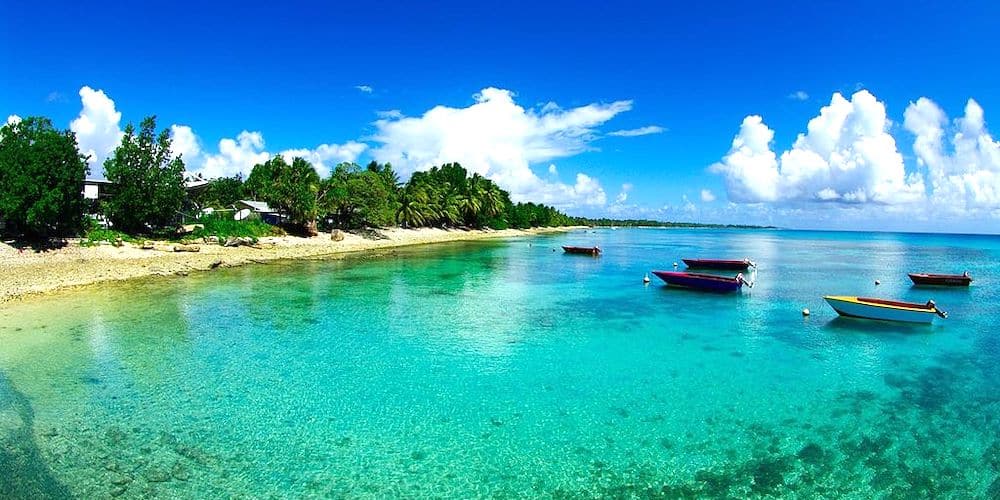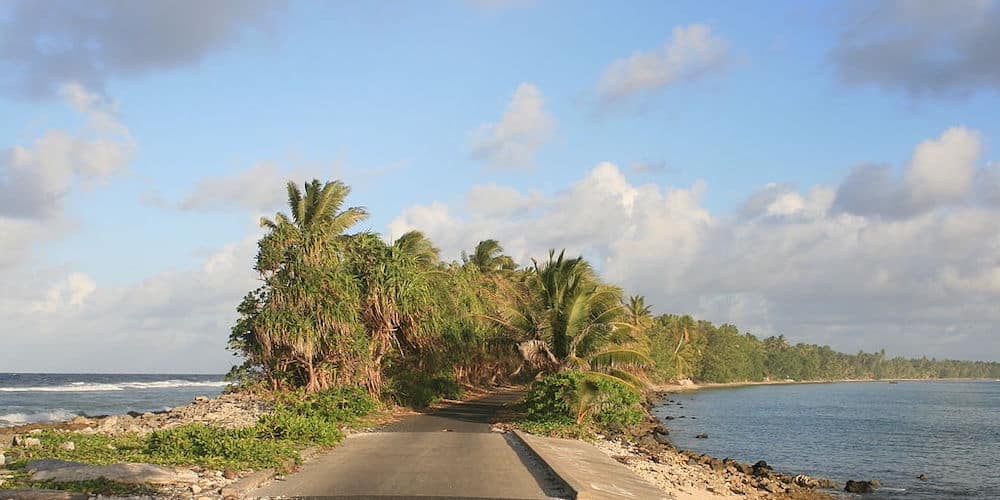Tuvalu

Tuvalu, formerly known as the Ellice Islands, is a Polynesian island nation located in the Pacific Ocean midway between Hawaii and Australia. It lies east-northeast of the Santa Cruz Islands (which belong to the Solomon Islands), northeast of Vanuatu, southeast of Nauru, south of Kiribati, west of Tokelau, northwest of Samoa and Wallis and Futuna, and north of Fiji. Its nearest neighbours are Kiribati, Samoa and Fiji. It is comprised of four reef islands and five true atolls. Its population of c. 12,000 people makes it the third-least populated independent country in the world, with only Vatican City and Nauru having fewer inhabitants. It is also the second-smallest member by population of the United Nations. In terms of physical land size, at just 26 km2 (10 square miles) Tuvalu is the fourth smallest country in the world, larger only than the Vatican City, Monaco and Nauru.
Tuvalu is a volcanic archipelago, and consists of three reef islands (Nanumanga, Niutao and Niulakita) and six true atolls (Funafuti, Nanumea, Nui, Nukufetau, Nukulaelae and Vaitupu). Its small, scattered group of atolls has poor soil and the land area is very low lying with narrow coral atolls. Funafuti is the largest atoll of the nine low reef islands and atolls that form the Tuvalu volcanic island chain. It comprises numerous islets around a central lagoon. An annular reef rim surrounds the lagoon, with several natural reef channels.

Tuvalu – ©INABA Tomoaki CC BY-SA 2.0 < >, via Wikimedia Commons
The highest elevation is five meters (16 ft) above sea level, which gives Tuvalu the second-lowest maximum elevation of any country (after the Maldives). Because of this low elevation, the islands that make up this nation may be threatened by any future sea level rise. Under such circumstances, the population may evacuate to New Zealand, Niue or the Fijian island of Kioa. Additionally, Tuvalu is affected by what is known as a King Tide, which can raise the sea level higher than a normal high tide. In the future, this may threaten to submerge the nation entirely. Tuvalu has very poor land and the soil is hardly usable for agriculture. There is almost no reliable supply of drinking water. The predominant vegetation type on the islands of Tuvalu is the cultivated coconut woodland, which covers 43% of the land. The native broadleaf forest is limited to 4.1% of the vegetation types. Tuvalu contains the Western Polynesian tropical moist forests terrestrial ecoregion.
Tuvalu experiences two distinct seasons, a wet season from November to April and a dry season from May to October. Westerly gales and heavy rain are the predominant weather conditions from November to April, the period that is known as Tau-o-lalo, with tropical temperatures moderated by easterly winds from May to October. Tuvalu experiences the effects of El Niño and La Niña, which is caused by changes in ocean temperatures in the equatorial and central Pacific. El Niño effects increase the chances of tropical storms and cyclones, while La Niñan effects increase the chances of drought. Typically the islands of Tuvalu receive between 200 and 400 mm (8 and 16 in) of rainfall per month. The central Pacific Ocean experiences changes from periods of La Niña to periods of El Niño.
Birding Tuvalu
The Funafuti Conservation Area consists of 12.74 square miles (33.00 square kilometres) of ocean, reef, lagoon, channel and six uninhabited islets.

Northern Funafuti – ©Davidarfonjones CC BY-SA 3.0 via Wikimedia Commons
There are a tiny number of birds; the only land birds being feral Red Junglefowl, Pacific Imperial-Pigeon and Long-tailed Koel, which is a migrant. The rest of the 37 species ever recorded are seabirds and waders. Only thirteen species have bred, nine of which are seabirds. The others are Pacific Reef-heron, Pacific Imperial-pigeon and Buff-banded Rail, along with the introduced Red Junglefowl.
-
Wikipedia
GNU Free Documentation License
https://en.wikipedia.org/wiki/Tuvalu
-
Number of bird species: 37
(As at December 2024)
-
Avibase
PDF ChecklistThis checklist includes all bird species found in Tuvalu , based on the best information available at this time. It is based on a wide variety of sources that I collated over many years. I am pleased to offer these checklists as a service to birdwatchers. If you find any error, please do not hesitate to report them. -
Wikipedia
Annotated ListThirty-seven species of birds have been recorded on Tuvalu, one of which has been introduced by humans. Thirteen of these species, nine of which are seabirds, breed in the country. -
eBird
PDF ChecklistThis checklist is generated with data from eBird (ebird.org), a global database of bird sightings from birders like you. If you enjoy this checklist, please consider contributing your sightings to eBird. It is 100% free to take part, and your observations will help support birders, researchers, and conservationists worldwide.
-
A Guide to the Birds of Fiji and Western Polynesia
| (including American Samoa, Niue, Samoa, Tokelau, Tonga, Tuvalu and Wallis & Futuna) | by Dick Watling | Dick Watling | 2004 | Paperback | 272 pages, 16 col plates, figs, tabs, maps | Out of Print | ISBN: 9789829030047 Buy this book from NHBS.com
-
*Protected areas of Tuvalu
InformationSatellite ViewProtected areas of Tuvalu consist of protected areas located within the central Pacific country of Tuvalu and its territorial waters. One such area is the Funafuti Conservation Area, which is a marine protected area on the western reef area of Funafuti atoll. -
Funafuti Conservation Area
WebpageSatellite ViewThe Funafuti Conservation Area is a marine conservation area covering 33 square kilometers (12.74 square miles) of reef, lagoon and motu (islets) on the western side of Funafuti atoll in Tuvalu.

